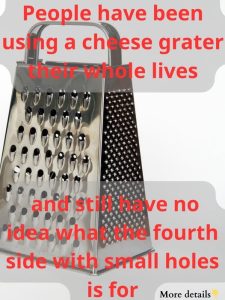
It’s a classic kitchen moment—you open the drawer, rummage past the spatulas and tongs, and pull out that trusty, boxy cheese grater. It’s been there for years, a dependable go-to when you need to turn a block of cheese into something meltable, sprinkleable, or sauce-worthy. Whether you’re topping pasta, prepping vegetables, or finishing a dessert, the cheese grater is one of those quiet, everyday tools that rarely lets you down.
But have you ever taken a closer look at it? More specifically—have you ever paused to wonder what the fourth side is actually for?
You probably know the basics:
-
The large holes? Perfect for shredding harder cheeses like cheddar, Gruyère, or mozzarella. They’re the go-to for topping casseroles or stuffing tacos.
-
The medium holes? These are your multi-purpose grating surface. They’re great for softer cheeses, carrots, zucchini, or chocolate.
-
The slicer side? That smooth, horizontal blade creates uniform slices of veggies, cheese, or even apples—ideal for sandwiches, gratins, or snack platters.
But then there’s that enigmatic fourth side—a curious panel covered with tiny, slightly raised, sharp-edged holes. Most people skip right over it, unsure whether it’s broken, outdated, or just there for show. But here’s the twist: that overlooked side might actually be the most underrated and versatile feature of the entire grater.
What’s the Deal with Those Tiny Holes?
This fourth side is typically used for fine grating or zesting, and it excels at it. The holes are designed to create ultra-fine shreds or dust-like particles from hard ingredients. You may have seen this texture on store-bought pre-grated parmesan—the kind that melts beautifully on top of hot pasta or pizza without clumping. That’s the effect this side of the grater delivers.
